A well-maintained yard is a source of pride and enjoyment for many homeowners. But when uninvited guests start digging holes in your yard, it can quickly become a source of frustration. Various animals can cause damage to your lawn and garden, leading to unsightly holes, destroyed plants, and potential trip hazards. To effectively manage and prevent these issues, it is important to understand which animals are responsible for digging holes in yards and how to stop them.
This article will uncover the mystery of the seven most notorious animals that dig holes in yards. By exploring their physical characteristics, diet, habits, signs of activity, and their impacts on your yard, you will be better equipped to address their challenges. Additionally, we will provide specific tips on how to stop each of these animals and discuss preventative measures to protect your yard from future intrusions.
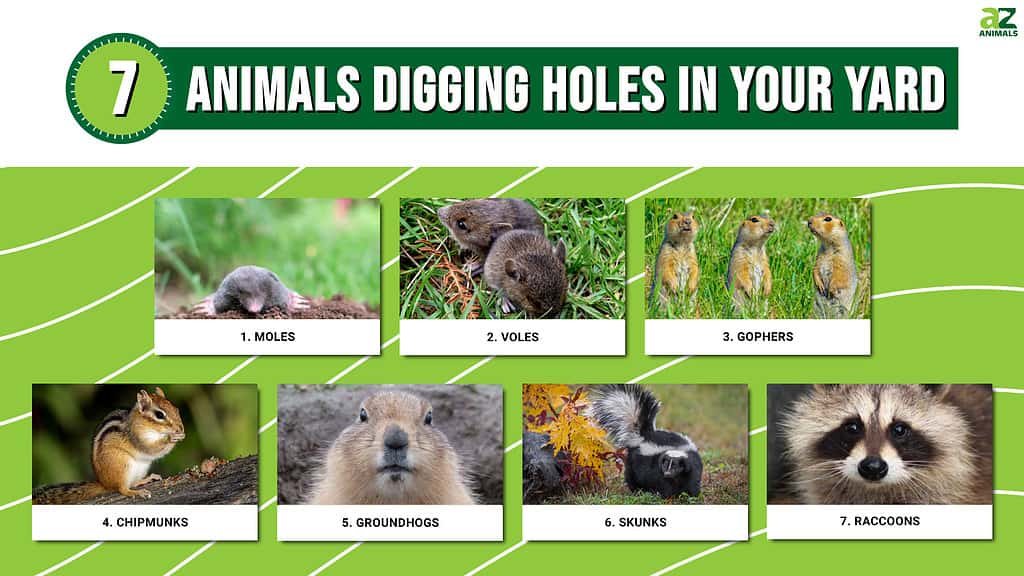
1. Moles: The Subterranean Earth Movers
Moles are often the culprits behind mysterious raised tunnels and earth mounds. They are the number one animal digging holes in yards. These small, burrowing mammals are experts at moving through the soil, making them efficient excavators. While they can be helpful in controlling insects and aerating the soil, their digging habits can also cause significant damage to lawns and gardens.
Physical Characteristics
Moles are small, burrowing mammals known for their cylindrical bodies, velvety fur, and broad, paddle-like front limbs adapted for digging. They have tiny, concealed ears and small eyes, which are not particularly useful given their subterranean lifestyle.
Diet and Habits
Moles primarily feed on insects, earthworms, and grubs, which they find in the soil.
They create a network of tunnels, both shallow and deep, to search for food. Moles are solitary animals and are most active during early mornings and late afternoons.
Signs of Mole Activity
The presence of raised ridges and molehills in your yard can identify mole activity. Molehills are small mounds of soil created as moles push the excavated earth to the surface while digging their tunnels. Raised ridges are formed by shallow tunnels that moles use for feeding.
How to Stop Them
To stop moles from digging holes in your yard, you can employ a variety of control methods. These may include using mole traps, such as scissor traps or harpoon traps, which are designed to capture or kill moles in their tunnels.
Another option is to use repellents, such as castor oil granules or ultrasonic devices, to deter moles from entering your yard.
It is also essential to keep your yard well-maintained by mowing your lawn regularly and addressing any insect infestations that may attract moles.

Moles: “The Subterranean Earth Movers.”
©Liz Weber/Shutterstock.com
2. Voles: The Voracious Vegetation Nibblers
Voles are also called “field mice” or “meadow mice.” These small rodents can wreak havoc on yards and gardens by burrowing and feeding on plants. However, with their inconspicuous appearance, they can easily go unnoticed until the damage they cause becomes apparent.
Physical Characteristics
Voles are small, stocky rodents with short legs, rounded heads, and short, furry tails. Their fur can vary in color from brown to gray, and they typically measure around 4-6 inches in length. Voles have small, rounded ears and black eyes.
Diet and Habits
Voles are herbivores, feeding on a variety of plant materials such as:
- Roots
- Tubers
- Bark
- Seeds
- Foliage
They are most active during dawn and dusk, and their populations can fluctuate significantly from year to year.
Voles create extensive burrow systems with multiple entrance holes, often in tall grass or under thick ground cover.
Signs of Vole Activity
Signs of vole activity include:
- Small, round holes in the yard
- Gnawed plants and tree bark
- Shallow, visible runways through grass or groundcover
Voles can also create underground tunnels, which can cause the soil to feel spongy when walked on.
How to Stop Them
To control voles in your yard, you can employ the following methods:
- Habitat modification
- Exclusion
- Trapping
Start by keeping your yard well-maintained, mowing the grass regularly, and removing ground cover that can provide hiding spots for voles.
Employ fencing or hardware cloth around vulnerable plants or trees to protect them from vole damage.
Trapping voles using live traps or snap traps can also be an effective way to reduce their population.
Bait the traps with peanut butter or apple slices, and place them near active runways for the best results.
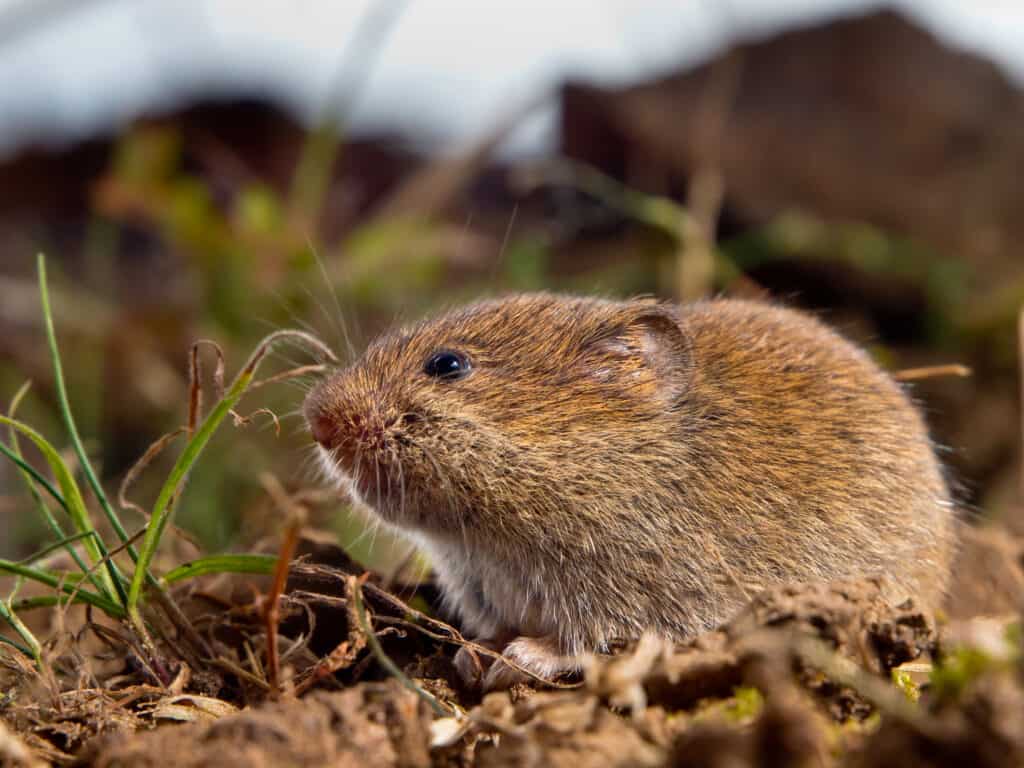
Voles: “The Voracious Vegetation Nibblers.”
©iStock.com/CreativeNature_nl
3. Gophers: The Underground Engineers
Gophers are burrowing rodents that can cause significant damage to yards by creating extensive tunnel systems and feeding on various plants. These underground engineers are notorious for the distinctive mounds they create in lawns and gardens. They are definitely the most ingenious animals digging holes in yards.
Physical Characteristics
Gophers, also known as pocket gophers, are medium-sized rodents with:
- Stout bodies
- Short legs
- Sharp claws adapted for digging
They have small eyes, short ears, and large, curved incisors that are visible even when their mouths are closed. Their fur is typically brown or gray, and they have fur-lined cheek pouches that they use to carry food.
Diet and Habits
Gophers are primarily herbivores, feeding on a wide range of plants, including:
- Roots
- Tubers
- Bulbs
- Some above-ground vegetation
They spend most of their lives underground, creating extensive tunnel systems to search for food and protect themselves from predators.
Gophers are solitary animals and tend to be most active during the early morning and late afternoon.
Signs of Gopher Activity
Gopher activity can be identified by the presence of crescent or horseshoe-shaped mounds of soil with a plugged hole at one end. These mounds are formed as gophers push excavated soil to the surface while digging holes in yards. Other signs of gopher activity include damaged plants and uprooted seedlings.
How to Stop Them
To control gophers in your yard, you can use a combination of the following methods:
- Trapping
- Baiting
- Fumigation
Traps, such as cinch traps or box traps, can be placed in active tunnels to capture or kill gophers.
Baiting with rodenticides can also be an effective way to control gophers. But it must be done carefully to avoid harming non-target animals.
Fumigation using gas cartridges can be employed to fill gopher tunnels with toxic gas, forcing the gophers to leave or killing them.
Additionally, using wire mesh barriers around vulnerable plants and trees can help protect them from gopher damage.

Gophers: “The Underground Engineers.”
©paha1205/Shutterstock.com
4. Chipmunks: The Adorable Ground Dwellers
Chipmunks, despite their small size and endearing appearance, can cause damage to yards by digging burrows and feeding on plants, seeds, and bulbs. These ground-dwelling rodents are swift and agile and can be challenging to manage.
Physical Characteristics
Chipmunks are small rodents with distinctive, bushy tails and characteristic stripes running down their backs and faces. They have rounded ears, large eyes, and sharp claws for digging. Chipmunks can vary in color from reddish-brown to gray, with lighter underbellies.
Diet and Habits
Chipmunks have a diverse diet that includes seeds, nuts, fruits, vegetables, insects, and even small animals like baby birds and eggs.
They are known for their food-gathering behavior, as they stuff their large cheek pouches with food to transport it back to their burrows.
Chipmunks are most active in the early morning and late afternoon.
Signs of Chipmunk Activity
Signs of chipmunk activity include small, round holes in the yard, gnawed plants, and scattered seed shells.
Chipmunk burrows typically have one main entrance and multiple escape tunnels, which can be difficult to locate. However, their presence may also be indicated by their distinctive chirping calls.
How to Stop Them
To control chipmunks in your yard, you can use a combination of the following methods:
- Trapping
- Exclusion
- Habitat modification
Live traps, such as Havahart traps, can be baited with peanut butter or sunflower seeds to capture chipmunks. Once captured, they should be relocated to a suitable location far from your property.
Exclusion methods can help prevent chipmunks from causing damage. They include:
- Sealing off potential entry points to your home or garden shed
- Using hardware cloth to protect vulnerable plants
Habitat modification, such as removing bird feeders and cleaning up fallen nuts and seeds, can make your yard less attractive to chipmunks.
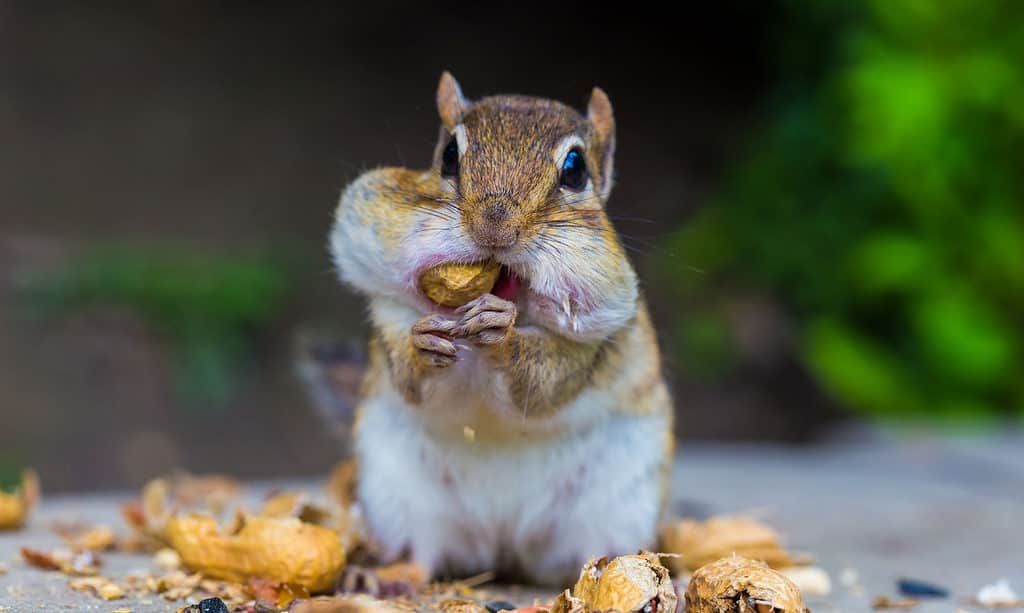
Chipmunks: “The Adorable Ground Dwellers.”
©colacat/Shutterstock.com
5. Groundhogs: The Burrow-Building Garden Raiders
Groundhogs, also known as woodchucks, are large rodents known for their burrow-building skills and voracious appetites for garden plants. Their digging and feeding habits can significantly damage yards and gardens.
Physical Characteristics
Groundhogs are stocky rodents with:
- Short legs
- Strong claws
- A thick, bushy tail
They have grizzled, brownish-gray fur and can weigh up to 10 lbs. Groundhogs have rounded ears, small eyes, and large incisors for gnawing.
Diet and Habits
Groundhogs are primarily herbivores, feeding on a variety of plants, including:
- Grasses
- Fruits
- Vegetables
- Tree bark
They’re most active in the early morning and late afternoon.
Groundhogs hibernate during the winter and are solitary animals except during the breeding season.
Signs of Groundhog Activity
Signs of groundhog activity include:
- Large, crescent-shaped mounds of soil near the entrance to their burrows
- Damaged plants with large, jagged bite marks
Groundhogs are animals famous for digging holes in yards. Their burrows typically have multiple entrances and can be extensive, with tunnels reaching up to 45 feet.
How to Stop Them
To control groundhogs in your yard, you can use a combination of the following methods:
- Eviction
- Trapping
- Exclusion
Eviction fluids, which are commercially available repellents that mimic the scent of predator urine, can be applied near burrow entrances to encourage groundhogs to leave.
Live traps can be baited with fruits or vegetables and placed near active burrows to capture groundhogs, which should then be relocated to a suitable location away from your property.
Exclusion methods, such as installing fencing or hardware cloth around gardens and vulnerable plants, can help prevent groundhogs from accessing and damaging your yard.
Burrow fumigation with gas cartridges can also be employed to eliminate groundhogs in their burrows. But this method should be used cautiously due to its potential impact on non-target animals.
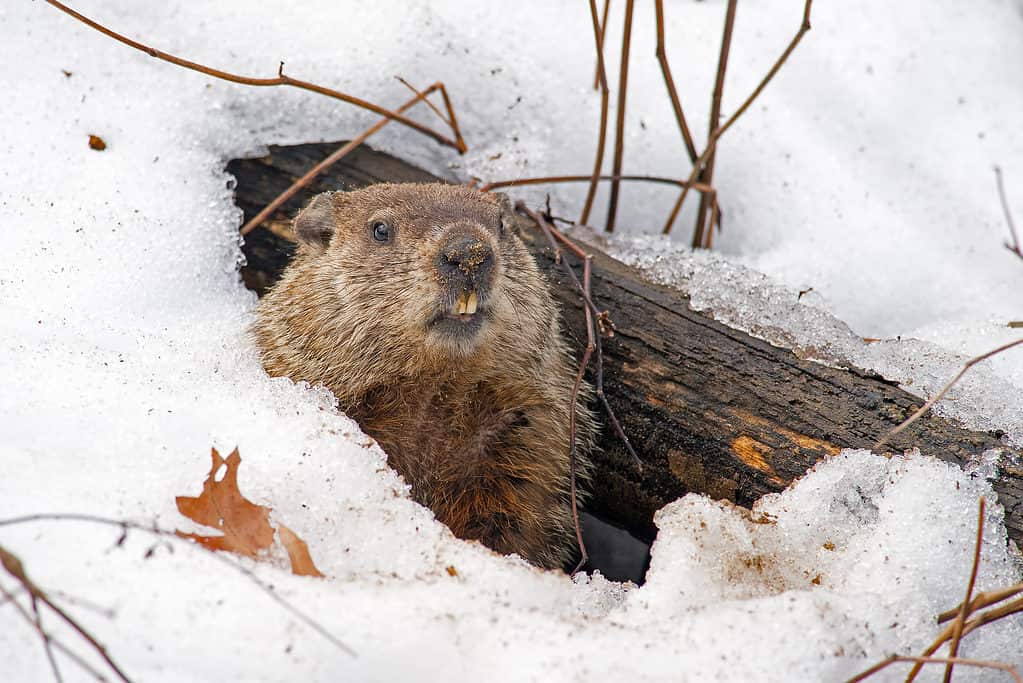
Groundhogs: “The Burrow-Building Garden Raiders.”
©Brian E Kushner/Shutterstock.com
6. Skunks: The Odiferous Diggers
Skunks are nocturnal mammals known for their ability to spray a pungent odor when threatened. Although their primary defense mechanism is their smell, skunks can also cause damage by digging holes in yards in search of food.
Physical Characteristics
Skunks are medium-sized mammals with distinctive black and white striped coats. They have bushy tails, short legs, and sharp claws adapted for digging. Skunks have small, rounded ears and a pointed snout, which they use to probe the soil for insects and grubs.
Diet and Habits
Skunks are omnivores, feeding on a wide range of foods, including:
- Insects
- Grubs
- Small mammals
- Fruits
- Plants
They are most active at night and are known to be opportunistic feeders, taking advantage of easily accessible food sources such as garbage cans and pet food dishes.
Signs of Skunk Activity
Signs of skunk activity in your yard include:
- Small, cone-shaped holes in the soil
- A strong odor
- Damaged plants
Skunks may also create dens under structures like decks, porches, or sheds, where they can leave behind droppings and odor.
How to Stop Them
To control skunks in your yard, you can use a combination of the following methods:
- Exclusion
- Repellent
- Habitat modification
Exclusion techniques, such as sealing off potential entry points to structures and installing fencing or hardware cloth around gardens, can help prevent skunks from accessing and damaging your yard.
Commercially available repellents, including those made with capsaicin or other irritants, can be applied around the yard to deter skunks.
Habitat modification, such as removing food sources like garbage cans and pet food dishes and eliminating hiding spots like brush piles and tall grass, can make your yard less appealing to skunks.
In some cases, live trapping may be necessary to remove skunks from your property. But it is crucial to check local regulations and guidelines before attempting to trap and relocate skunks, as well as to take precautions to avoid being sprayed.
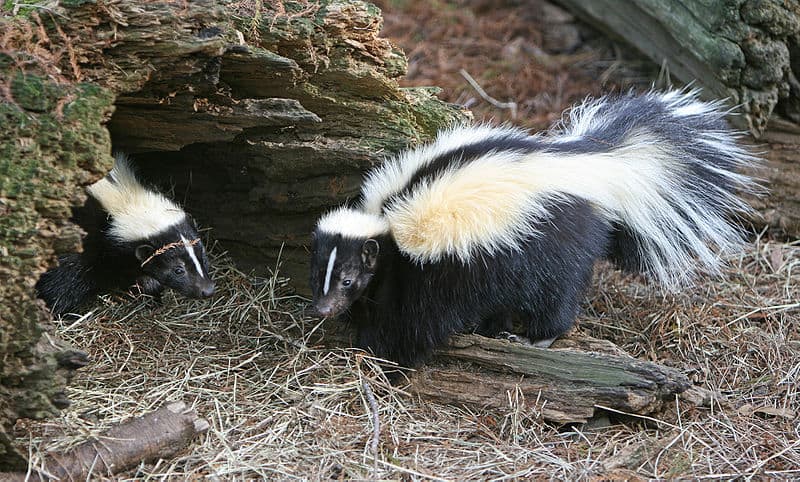
Skunks: “The Odiferous Diggers.”
7. Raccoons: The Clever Nighttime Nuisances
Raccoons are intelligent, nocturnal mammals known for their dexterous paws and ability to raid garbage cans and gardens for food. Although they usually prefer to inhabit wooded areas, raccoons have become a common sight in urban and suburban neighborhoods, where their foraging habits can lead to damage in yards.
Physical Characteristics
Raccoons are medium-sized mammals with distinctive black masks across their eyes and a bushy, ringed tail. They have a grayish-brown coat, sharp claws for climbing, and highly dexterous front paws, which they use to manipulate objects and search for food. Raccoons are stocky and can weigh up to 20 lbs. or more.
Diet and Habits
Raccoons are omnivores, feeding on a wide variety of foods, including:
- Fruits
- Vegetables
- Insects
- Fish
- Small mammals
- Human food waste
They are most active at night and are known for their problem-solving abilities, which enable them to access seemingly secure food sources like garbage cans and pet food dishes.
Signs of Raccoon Activity
Signs of raccoon activity in your yard include:
- Overturned garbage cans
- Scattered trash
- Damaged plants or crops
- Tracks with five distinct toe prints
Raccoons may also create dens in attics, chimneys, or under structures like decks and sheds, leaving behind droppings and urine.
How to Stop Them
To control raccoons in your yard, you can use a combination of the following methods:
- Exclusion
- Repellent
- Habitat modification
Exclusion techniques can help prevent raccoons from accessing and damaging your property. They include:
- Securing garbage cans with locking lids or straps
- Sealing off potential entry points to structures
- Installing fencing or electric barriers around gardens
Commercially available repellents, including those made with capsaicin or other irritants, can be applied around the yard to deter raccoons.
Habitat modification can make your yard less appealing to raccoons. They include:
- Removing food sources like pet food dishes and bird feeders
- Eliminating hiding spots like brush piles and woodpiles
In some cases, live trapping may be necessary to remove raccoons from your property. But it’s crucial to check local regulations and guidelines before attempting to trap and relocate raccoons.
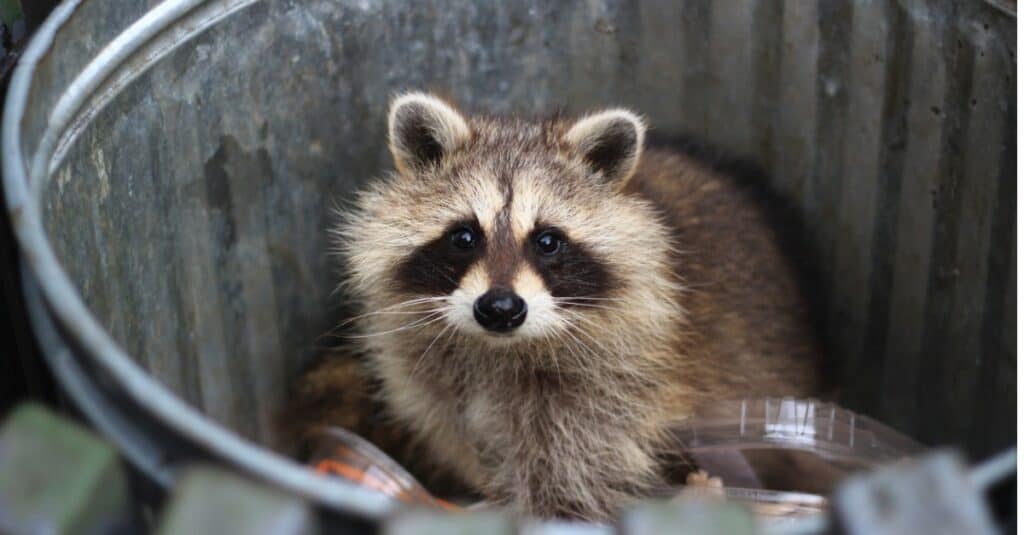
Raccoons: “The Clever Nighttime Nuisances.”
©iStock.com/Dahrs
Wrapping Up
We have explored seven notorious animals that can cause damage to yards and gardens by digging holes and foraging for food. Each animal has its unique characteristics, habits, and signs of activity, making it essential to identify the culprit correctly before taking action. By understanding the behavior of these animals, homeowners can employ a combination of exclusion, repellent, and habitat modification techniques to protect their yards and gardens from unwanted damage. Ultimately, maintaining a balance between human activities and the natural habitats of these animals is crucial to ensure a harmonious coexistence. By employing effective and humane strategies to control their impact on our yards, we can appreciate the beauty and diversity of wildlife while preserving the health and aesthetics of our outdoor spaces.
The photo featured at the top of this post is © iStock.com/juefraphoto
Thank you for reading! Have some feedback for us? Contact the AZ Animals editorial team.






